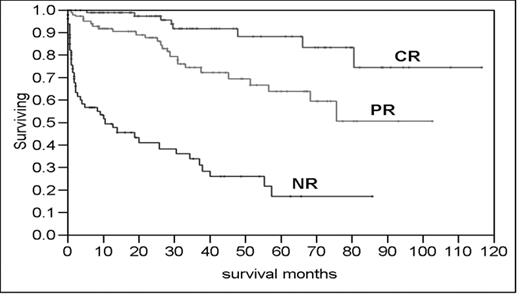Abstract
INTRODUCTION
Stem cell transplant has been increasingly used in the initial therapy of newly diagnosed systemic AL. Introduction of the free light chain assay has made it easier to quantify responses in patients with AL. It is unclear whether the goal of therapy should be a hematologic response or, as in multiple myeloma, a complete response. This paper addresses the impact of the degree of response on outcome.
PATIENTS AND METHODS
282 consecutively transplanted patients are included in this analysis. None of the patients were excluded. There were 169 men (59%). 28% of the cohort have died. 69% had renal involvement, 51% cardiac involvement, 11% peripheral nerve involvement, 16% hepatic involvement. The median percentage of plasma cells at the time of transplant was 7. Echocardiographic analysis revealed a median septal thickness of 12 and a median ejection fraction of 65%. Patients ranged in age from 31 to 71 with a median of 57 years and were transplanted at a median of 4.2 months following histologic diagnosis of amyloidosis. 27% of patients received reduced intensity conditioning usually due to moderate cardiomyopathy or renal insufficiency. 201 patients achieved a hematologic response and 93 of these achieved a complete response. The criteria for response were reported in accord with the consensus definition for response established at The Xth International Symposium on Amyloid and Amyloidosis. A complete response required immunofixation negativity of serum and urine with a normal free light chain ratio. A hematologic objective response required a 50% reduction of serum and urine monoclonal protein with a 50% reduction in the free light chain value. Figure 1 shows the Kaplan Meier curves demonstrating the survival of all patients based on whether they achieved a complete response, partial response, or failed to achieve response. There were 93 CR, 108 PR, and 81 nonresponders. The differences in all three curves are significant at P<.001. Figure 2 demonstrates the same cohort of patients using a six month landmark analysis to exclude the effect of treatment related mortality on outcome. There were 86 CR, 91 PR, and 36 NR for a total of 213 patients. There was a difference in response rate based on conditioning intensity (p<0.01) and age (p=0.046). The median survival was only reached in the NR at 40.1 months and, in the landmark analysis the differences between all three survival curves were statistically significant.
CONCLUSION
Patients who achieve a hematologic complete response following sct for AL do better than other patients. Patients who achieve an objective response have a superior outcome than patients who fail to achieve a hematologic response, in a landmark analysis at six months. It is unclear if consolidation chemotherapy should be offered to partial responders in an attempt to convert them into CR’s.
Disclosures: Novartis.



